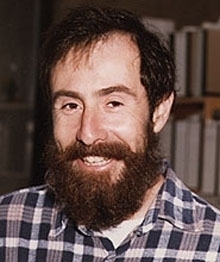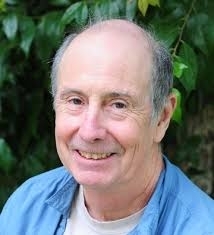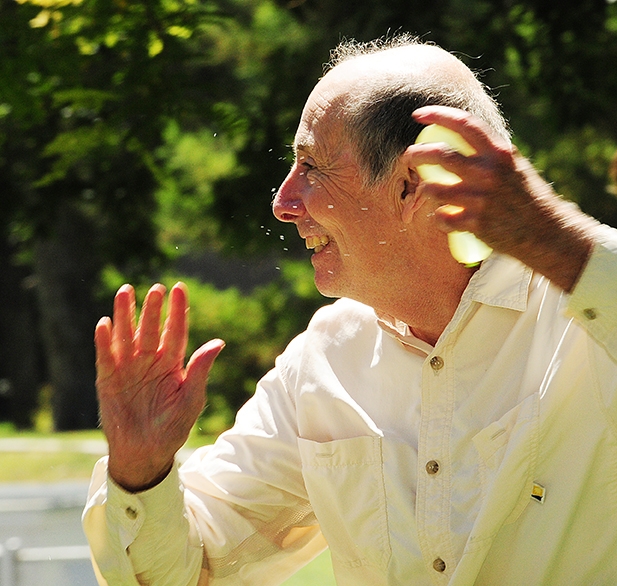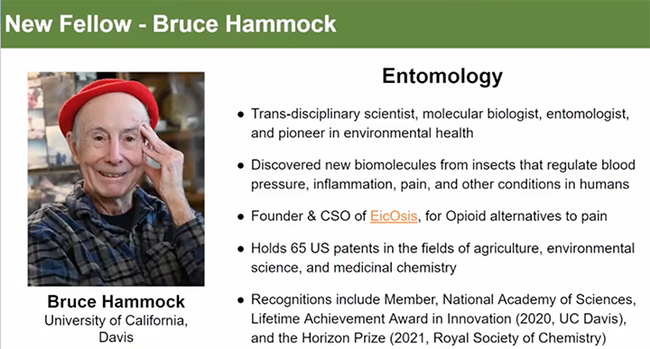
Hammock, internationally recognized for discovering a new group of human chemical mediators, is a newly inducted Fellow of the California Academy of Sciences (CAS). (He's also our favorite to some day win the Nobel Prize, as we've told him many times!)
Hammock, who holds a joint appointment with the Department of Entomology and Nematology and the UC Davis Comprehensive Cancer Center, was inducted along with 13 other Fellows on Nov. 14 during the annual Fellowship meeting. He joins the ranks of more than 500 Academy Fellows, a governing group of distinguished scientists and other leaders who have made notable contributions to scientific research, education, and communication.
“We're proud to announce 2023's distinguished pool of new Fellows—each of their contributions to science and society represent major advancements in their respective fields,” said Academy Dean of Science and Research Collections Shannon Bennett. “Our Fellows body is a group of future thinkers and innovators whose leadership inspires the next generation of scientists, science educators, story-tellers and change-makers. We look forward to forging a future with our new Fellows that advances the Academy's mission to regenerate the natural world through science, learning, and collaborative partnerships.”
A member of the UC Davis faculty since 1980, Hammock was nominated by colleagues James R. Carey, UC Davis distinguished professor, and Robert E. Page Jr., UC Davis distinguished emeritus professor and emeritus provost of Arizona State University. The CAS Board of Trustees selects the Fellows.
Hammock discovered that regulating degradation of insect hormone mediators is as important as biosynthesis in development. He applied this toward the development of green chemical and the first recombinant viral pesticide. He asked if the same systems of metabolism of chemical mediators could be important in other species, notably man, resulting in the discovery of a new group of human chemical mediators. By inhibiting a key enzyme in this pathway, beneficial natural mediators increased there by showing benefit in treating multiple diseases including arthritis, cancer, Alzheimer's with the resulting drug candidates currently in human trials to treat pain.

Hammock founded the Davis-based pharmaceutical company, EicOsis LLC, formed in 2011 to develop an orally active non-addictive drug for inflammatory and neuropathic pain. The former chief executive officer, he now serves on the board of directors.
Hammock directed the UC Davis Superfund Research Program (funded by the National Institutes of Health's National Institute of Environmental Health Sciences) for nearly four decades, supporting scores of pre- and postdoctoral scholars in interdisciplinary research in five different colleges and graduate groups on campus.
He is a fellow of the National Academy of Inventors and the National Academy of Sciences., and the Entomological Society of America. He is the recipient of scores of awards, including the first McGiff Memorial Awardee in Lipid Biochemistry; and the Bernard B. Brodie Award in Drug Metabolism, sponsored by the America Society for Pharmacology and Experimental Therapeutics. At UC Davis he received the Distinguished Teaching Award and the Faculty Research Lectureship. In 2020, he received a Lifetime Achievement Award from UC Davis Chancellor Gary May.

Hammock is known for his expertise in chemistry, toxicology, biochemistry and entomology. Early in his career, he founded the field of environmental immunoassay, using antibodies and biosensors to monitor food and environmental safety, and human exposure to pesticides. His groundbreaking research in insect physiology, toxicology led to his development of the first recombinant virus for insect control.
A native of Little Rock, Ark., Hammock received his bachelor's degree in entomology (with minors in zoology and chemistry) magna cum laude from Louisiana State University, Baton Rouge, in 1969. He received his doctorate in entomology-toxicology from UC Berkeley in 1973. Hammock served as a public health medical officer with the U.S. Army Academy of Health Science, San Antonio, and as a postdoctoral fellow at the Rockefeller Foundation, Department of Biology, Northwestern University, Evanston, Ill.
In the Army, he served as a medical officer at Fort Sam, Houston, and what he saw--severely burned people in terrible pain--made a lasting impression on him and steered him toward helping humankind.
Fun Fact: For years Hammock--who believes science should be fun and camaraderie is crucial-- hosted water balloon battles on the Briggs Hall lawn. It was not "Fifteen Minutes of Fame"; it was "Fifteen Minutes of Aim." See Bug Squad blog.
Check out UC Davis distinguished professor Walter Leal's video of the Fellows' induction. (A screen shot is below) Leal is on X (used to be Twitter) at @wsleal2014.
Attached Images:
